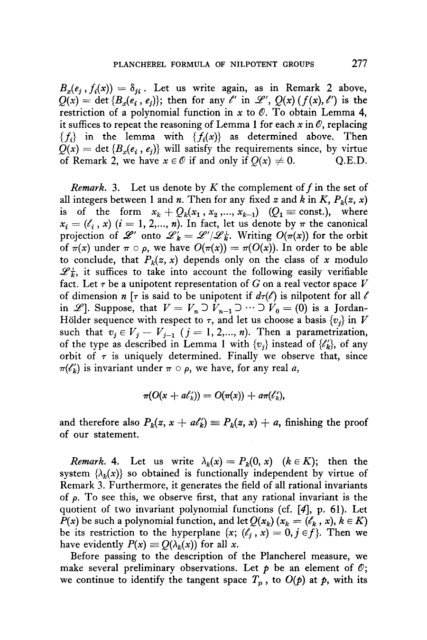On the Characters and the Plancherel Formula of Nilpotent Groups ...
On the Characters and the Plancherel Formula of Nilpotent Groups ...
On the Characters and the Plancherel Formula of Nilpotent Groups ...
Create successful ePaper yourself
Turn your PDF publications into a flip-book with our unique Google optimized e-Paper software.
PLANCHEREL FORMULA OF NILPOTENT GROUPS 277<br />
B,(ej , h(x)) = 8, . Let us write again, as in Remark 2 above,<br />
Q(x) = det (R& , e.)}; 3 <strong>the</strong>n for any el in .A?‘, Q(X) (f(x), el) is <strong>the</strong><br />
restriction <strong>of</strong> a polynomial function in x to 0. To obtain Lemma 4,<br />
it suffices to repeat <strong>the</strong> reasoning <strong>of</strong> Lemma 1 for each x in 0, replacing<br />
{fi} in <strong>the</strong> lemma with {fi(x)} as determined above. Then<br />
Q(x) = det VW+ , e.)} 3 will satisfy <strong>the</strong> requirements since, by virtue<br />
<strong>of</strong> Remark 2, we have x E 0 if <strong>and</strong> only if Q(x) f 0. Q.E.D.<br />
Remark. 3. Let us denote by K <strong>the</strong> complement <strong>of</strong>f in <strong>the</strong> set <strong>of</strong><br />
all integers between 1 <strong>and</strong> n. Then for any fixed z <strong>and</strong> k in K, Pk(z, x)<br />
is <strong>of</strong> <strong>the</strong> form xk + Qk(xl, x2 ,..., x& (Qi = const.), where<br />
xi = (li , x) (i = 1, 2 )..., n). In fact, let us denote by n <strong>the</strong> canonical<br />
projection <strong>of</strong> 9 onto 9i = -E”‘/5?$. Writing 0(+x)) for <strong>the</strong> orbit<br />
<strong>of</strong> n(x) under rr o p, we have O(n(x)) = rr(O(x)). In order to be able<br />
to conclude, that Pk(z, x) depends only on <strong>the</strong> class <strong>of</strong> x modulo<br />
.9’;, it suffices to take into account <strong>the</strong> following easily verifiable<br />
fact. Let T be a unipotent representation <strong>of</strong> G on a real vector space V<br />
<strong>of</strong> dimension n [T is said to be unipotent if &(e) is nilpotent for all e<br />
in 91. Suppose, that V = V, 1 V,-, 3 a** 1 V, = (0) is a Jordan-<br />
Holder sequence with respect to T, <strong>and</strong> let us choose a basis {Us> in V<br />
such that vj E Vj - V,+, (j = 1, 2,..., n). Then a parametrization,<br />
<strong>of</strong> <strong>the</strong> type as described in Lemma I with {vi} instead <strong>of</strong> {&}, <strong>of</strong> any<br />
orbit <strong>of</strong> 7 is uniquely determined. Finally we observe that, since<br />
r(&) is invariant under 7r o p, we have, for any real a,<br />
40(x + 4)) = 0(4x)) + a&>,<br />
<strong>and</strong> <strong>the</strong>refore also Pk(z, x + a&) = Pk(z, X) + a, finishing <strong>the</strong> pro<strong>of</strong><br />
<strong>of</strong> our statement.<br />
Remark. 4. Let us write X,(x) = Pk(O, X) (k E K); <strong>the</strong>n <strong>the</strong><br />
system {A,(x)} so obtained is functionally independent by virtue <strong>of</strong><br />
Remark 3. Fur<strong>the</strong>rmore, it generates <strong>the</strong> field <strong>of</strong> all rational invariants<br />
<strong>of</strong> p. To see this, we observe first, that any rational invariant is <strong>the</strong><br />
quotient <strong>of</strong> two invariant polynomial functions (cf. [4], p. 61). Let<br />
P(x) be such a polynomial function, <strong>and</strong> let Q(+) (x, = (8, , x), k E K)<br />
be its restriction to <strong>the</strong> hyperplane (x; (4 , x) = 0,j ef }. Then we<br />
have evidently P(x) E Q(hk(x)) for all X.<br />
Before passing to <strong>the</strong> description <strong>of</strong> <strong>the</strong> <strong>Plancherel</strong> measure, we<br />
make several preliminary observations. Let p be an element <strong>of</strong> 0;<br />
we continue to identify <strong>the</strong> tangent space T, , to O(p) at p, with its

















